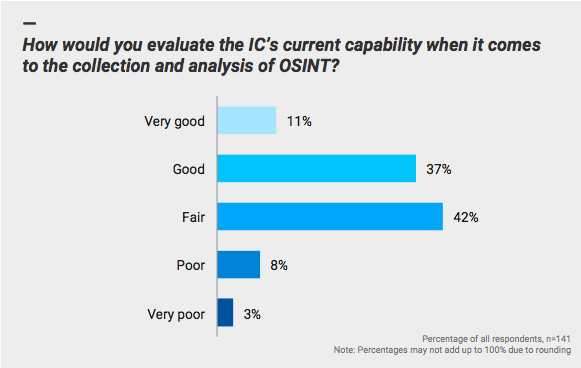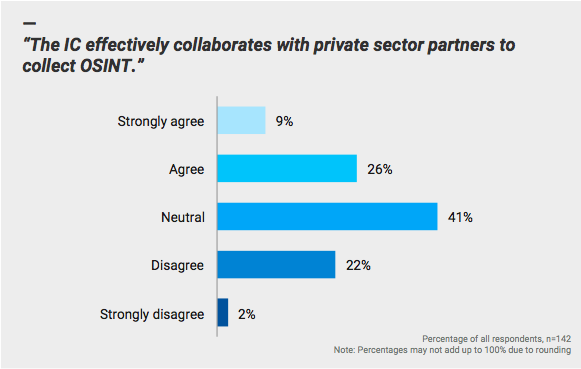
Poll Signals IC's Faith in Open Source Intelligence Capabilities

Two years ago, an ISIS recruiter went online to attract new talent. Within 24 hours, the Air Force division monitoring the group’s social media activity had pinpointed the recruiter’s location and launched a successful missile strike from hundreds of miles away.
While incidents like these are becoming more common, advocates of open source intelligence (OSINT) say more needs to be done to aid national security efforts, either by expanding collaboration with the private sector or innovating on existing tactics. A Government Business Council poll of 141 US intelligence and defense personnel conducted in late 2016 reinforces that sentiment:

While nearly half of those polled described government's collection and analysis of OSINT as good or very good, 1 in 4 disagreed with the statement that “the IC effectively collaborates with private sector partners to collect OSINT.”

In light of this gap, some agencies have taken proactive measures to expand engagement with the private sector. Robert Cardillo, director of the National Geospatial-Intelligence Agency (NGA), notes that investments in private sector technology and resources have been essential to his agency’s maturation into an OSINT powerhouse.
“Geospatial intelligence is at an inflection point,” says Cardillo, “and NGA finds itself in the midst of a professional revolution rich with game-changing opportunity and unbounded potential. Now fully 90 percent of our mapping, charting, and geodesy mission, and almost all of our humanitarian assistance missions, are dependent upon commercial satellite imagery.”
In 2015, NGA launched its GEOINT Pathfinder project to answer research questions exclusively by means of open, unclassified tools “available in the commercial and open source world.” Led by Chris Rasmussen, the initiative makes extensive use of code-sharing repository GitHub to publish unclassified, open-source geospatial projects and iterate on feedback received from the OSINT community.
Speaking at the Defense One Summit in November 2016, Rasmussen said his team realized the majority of the questions they looked at could be answered using basic ground analytic information provided by social media analysis, volunteer geographic information analysis, financial analysis, and unstructured text analysis. Scanning these disparate sources for insights enables the Pathfinder team to adopt what he calls the “coffee strategy.”
“Our goal is to deliver highly tailored, highly strategic analysis to a mobile device hours before our people enter a secure environment. So if we can answer eighty to ninety percent of the questions before analysts come into the SCIF [sensitive compartmented information facility] in the morning—where they’re drinking their morning coffee—that’s the goal.”
As for partnerships? “We need all the help we can get,” says Rasmussen, adding that partnerships with industry will be key to growing those broad networks.
This post is written by Government Business Council; it is not written by and does not necessarily reflect the views of Government Executive Media Group's editorial staff. For more information, see our advertising guidelines.